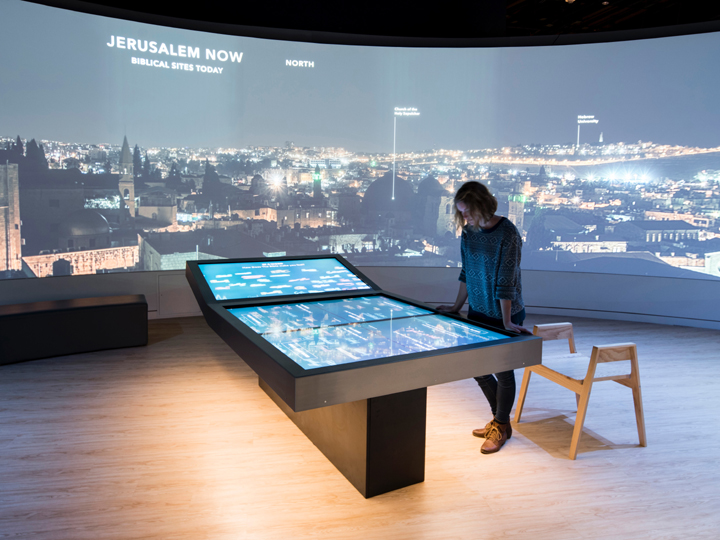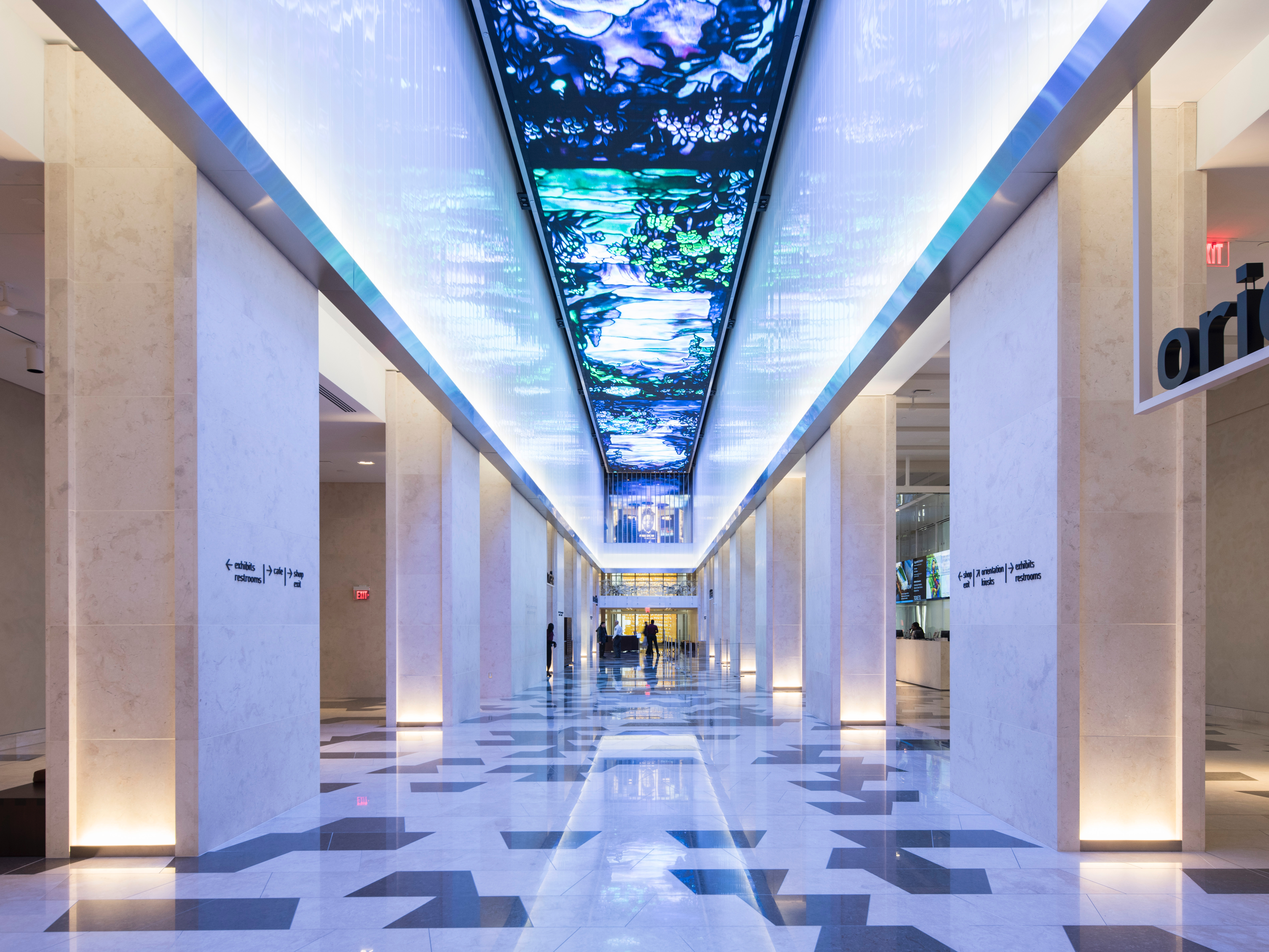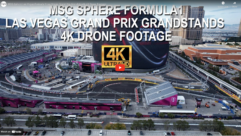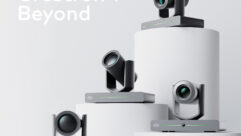On this edition of the SVC Podcast, Contributing Editor Bennett Liles talks with Matt Odell and Steve Frantz of S2N Technology Group about their AV work on the massive new Museum of the Bible in Washington, D.C. Matt and Steve discuss the unique ceiling video display in the Grand Hall, the sound and video systems in the World Stage Theater and the museum’s interactive digital docents that guide visitors around the 430,000 square foot building.
Links of Interest:
· The Museum of the Bible in Washington, D.C.
· S2N Technology Group in Bethesda, Maryland
· Museum of the Bible Extended Fly-Through Video
· Meyer Constellation System for digital variable acoustics
· Yamaha QL5 digital mixing console
This is the SVC Podcast from Sound & Video Contractor with Matt Odell and Steve Frantz of S2N Technology Group. As always, we’ve got show notes and product links for this and lots of other SVC podcasts at svconline.com. Just go to Podcasts at the top of the page.
The most fantastic new museum on the planet is open for business in Washington, D.C. The Museum of the Bible has taken the technology for historical exhibits and immersive AV environments to a new level. S2N Technology Group was at the center of it all. Matt Odell and Steve Frantz are going to tell us how their whole team made it happen, right now on the SVC Podcast.
Matt and Steve, it’s a real treat having you with us from the S2N Technology Group, a subsidiary of Clark Construction in Bethesda, Maryland. Here to talk about the brand new Museum of the Bible. What a project. A 430,000 square foot building about three blocks or so from the Capitol.
Matt: That’s correct.
A 600-million-dollar project and your people, from all accounts, did a fantastic job with this. S2N Technology Group was there from the beginning to the end so tell us about S2N and how you worked with your parent company Clark Construction in bringing the audiovisual experience here from the idea stage right on to real life on this project.
Matt: Well thanks, Bennett. S2N Technology Group, we’ve been around for about 14 years now. We bring the technology to the construction world, an area that for many years happened after new building construction was completed and then became that mad scramble for them to get all the technologies within the building. What we do is we work directly with the general contractor during construction as well as the owner’s IT group and everyone associated on the technology side because we speak both languages on technologies and construction. And we do the work during the construction and have things created and put in and all ready to go when we finish construction on a job. [Timestamp: 2:11]
And this was one heck of a job, something like five years from the beginning to opening the doors on this place. It’s multi-floor. I went over all of the videos on this and I’m just knocked over by it. So many immersive exhibits. Is most of the technical support structure for this located below the building all in one place or is it localized in a separate tech area on each floor?
Matt: It’s throughout the building, Bennett. There’s main areas down in the lower levels to support the enterprise network and a little bit more general things involved with the building. Then the exhibitors have spaces on each floor, technology rooms that they can run their data out of as well so it’s throughout the building. When you’re talking about a 430,000-square foot museum, you know, you can run into distance issues on things. So we had to put things throughout the complex. [Timestamp: 3:00]
And in this museum you get the whole story on the Bible. It takes you on a simulated flying tour of the places around Washington that have Bible inscriptions as part of them. You’ve got theaters and all kinds of interactive experiences. When you first walk in there, I think it’s called the Grand Hall, where you have a 15 foot wide LED arcade ceiling above you. What does that show and how does it operate?
Steve: The arcade is 140-foot long, 15-foot wide LED tile ceiling and it basically displays a lot of intricate digital art that the viewers and visitors can see once they come into that main lobby area. The ceiling itself is made up of 555 LED panels with a five millimeter pixel pitch. And again, the ceiling is surrounded by glass on both sides – so again, those images will reflect off of that and kind of enhance the digital ceiling designs. The content actually includes a lot of images from the museum’s collection, so it might be stained glass, views of landscapes, Bible illumination, scripture and different architectural elements from cathedrals, things like that. And basically as the guests go through the space throughout the day there’s different images that they’re going to see on that ceiling and it’s all based on some algorithms that are running on the video equipment to run different designs and different themes at different times. The content actually comes from a media server PC that’s connected to a video matrix switcher and those outputs are pathed through some LCD controllers that go via fiber to the fiber converters and receiver cars that are located up in the ceiling behind the LED tiles. And basically S2N, we were involved in coordinating this element into the construction schedule and then providing that cabling that included the fiber from a basement AV rack to the ceiling locations. So it’s a pretty impressive site to see once you walk in there and you’re getting prepared for your visit. [Timestamp: 4:58]
Along the lobby floor right there when you walk in and have that incredible ceiling display above you, there’s a series of glass-top tables and I found those very interesting in the videos. The camera swoops in right over these tables. What can visitors do with those and how did you make all of that work because it looks to be one of the most engaging parts of it.
Steve: Yeah, you’re right. That’s a key part of the museum’s technology package. And those glass-top tables are actually touch-enabled displays that are part of the digital docent system. And essentially what happens after entering the museum, visitors can choose to use a digital docent to guide them on a tour of the museum, and the tour is something they would kind of set up on their own. So essentially what happens is the visitors are provided a small handheld device which they place on those touch-enabled tables, and then once the devices are recognized by that table a visitor can pull elements to that device to create a tour of their own choosing. And once that information is loaded to the device, the visitor picks the device up and can walk around the museum with that to guide them to what they want to see. And again, it’s another technology element in the entire museum that’s unique to the museum and it involved many technology partners to implement. It was not just S2n, but we were certainly involved in coordinating with the owner and across the different technology partners that were involved to get all the infrastructure in place. One example are the beacons, or anchors, that had to be located throughout the museum in order to guide these devices and map these devices so that they could tell the device where it was located in the museum and be able to match up the tour that was created to the location the user was stationed at. So again, very cutting-edge technology, very interesting application across many areas of technology. [Timestamp: 6:46]

That must have been a real challenge in the design phase. The younger museum visitors probably notice that first and really get into the interactive aspect but you don’t want to make it so complex that the other visitors are kind of overwhelmed with it.
Matt: Bennett, if I may, this docent or digital guide system, while there’s been a lot of people that have tried to do this sort of thing, this is the only one of its kind that gets to the granularity that it does. And it’s based on these beacons, or these anchors, that were put in for it. And there was several companies involved with the design and the implementation of this. And it got to the point where the Museum of the Bible folks said hey, we’ve done this. Finally we’re going to go ahead and patent it as well. So they put in for a patent on this particular system. [Timestamp: 7:34]
It’s remarkable the way it can provide information and guide the visitors around so many impressive exhibits. One of the most impressive is the World Stage Theater. It’s not that big in terms of seating capacity but when you look at it, you’re just immersed in video from everywhere. How did you manage to integrate 17 4K projectors with a 100-foot ceiling in there?
Steve: Yeah, the World Stage Theater is a pretty amazing space to be in. It’s a space that hosts live performances, presentations, Bible readings. The opening was a Broadway musical that they had the first weeks and months they were opened. But the 17 projectors support a digital projection mapping and that mapping goes on the walls, the ceilings, and the front of the stage of the performance area. And those projectors are providing a very immersive, dynamic visual experience for the people in the theater. And again, this might be images, surface effects – and these are all things that compliment whatever programming is going on in the space. And the projection mapping requirement actually was added after design was complete and construction was underway so that we had to do quite a bit of work to coordinate and make those projectors be invisible. The architectural elements of the room consisted of some fabric-covered ribbons that basically go from one side of the room, across the ceiling, and down to the other side. And then there’s other surfaces that consist of customized acoustical wood panels. So again, mapping those images on those varied surfaces was quite a challenge, but like I said before we had to make sure all this equipment, 17 projectors, fit into the room and were able to be hidden as much as possible so as not to disturb the overall impact of the architectural features in there. You know, we needed to make sure that these projectors were supported as far as being able to be maintained later, to be accessible for maintenance, being cooled and also making sure that they were sound-isolated from the space because there was also an audio experience that was very important in the space as well, so a lot of coordination. And then one of the other pieces of this was the installation of dozens of light sensors that were installed throughout the space to enable the client to calibrate the system automatically without having to do a lot of manual adjustment. So that’s another part of the process that made this projection mapping system a very important part of the experience for the audience. [Timestamp: 9:58]
Since you mentioned the sound on this, I believe you selected a Yamaha mixer for the World Stage Theater.
Steve: Yeah. So the mixer was for front of house audio mixing so they decided to use Yamaha QL5 digital mixing console. And this was something that the owner’s support staff was interested in, and they particularly liked Yamaha for its reliability and flexibility. It was also a good fit for the requirements. It provided a good all-in-one solution for mixing, processing and routing audio, so they liked the idea of having remote control via tablet or computer as well as supporting Dante network. So that was also important to them as well. And then one of the key things about it, everything in this building had to be ready on opening day so again, museum support staff took training ahead of opening day to make sure they were familiar with this equipment – and all the equipment, to be honest – but certainly this mixer was key for them to support events in the space. [Timestamp: 10:57]
We’ve done several recent podcasts on the Meyer Constellation system and with that in the theater you can digitally adjust the acoustics instead of having to make changes to physical objects in the room. How does the Constellation system customize the sound environment to suit different events in the theater?
Matt: In the early stages of the project this was something that was really important to the customer no matter if they were going to put a Broadway show or a string quintet, if you will, in the space. They wanted the sound to match the event. We did an awful lot of research on these types of systems and had settled on the Meyer Constellation system early on because of the amount of equipment that was necessary for it. Within the space there’s 100 to 150 speakers. They’re all hidden behind those ribbons that Steve mentioned earlier. And there’s microphones within the space also. And what this does is the microphones kind of record the acoustic patterns within the space, run it through a series of algorithms, and then the speakers within there support those things to give the right acoustics for the right type of sound they want. So they can set these up so with the push of a button, if they want it to be a big symphony hall sound, they can push that button. And if they want it to be the string quartet sound they can push that button, too. It’s an amazing system and provides a fantastic listening experience within the house. [Timestamp: 12:27]

Yes, changing the acoustic nature of the room for whatever performance you have? All you would have to do initially is get the room into a more neutral acoustic response so that you can let the system work. It creates what I’m sure is a unique experience.
Matt: when you think about it, you have the visual piece from the projection mapping and you have the audio piece from the Meyer acoustic enhancement system. With all of that it’s just a fantastic place to go and see a show or just to sit and relax if they’re putting Bible verses across the ceiling and have an audio track playing as well. [Timestamp: 13:03]
The combination of the immersive displays all the way across the room and the Constellation system wrapping you in the sound. You probably just walk in there, sit down and just strap that theater on.
Matt: [Laughs] That’s right. Yep.
Good of you guys to tell us about this much of the project and we’ll get into some other aspects of it next week. I wish we had a Part 3, 4, 5 and 6 to go on with this. We’ve got Matt Odell and Steve Frantz from S2N Technology Group and the all new Museum of the Bible just opened a few blocks from the Capitol in Washington. We’ve got some video links and the place is a must-see for anybody going to Washington. Looking forward to hearing more next week.
Glad to have Matt Odell and Steve Frantz with us from S2N Technology Group. Next week they’re going to take us deeper into their work on The Museum of the Bible with the cabling, the displays and how S2N coordinated the installation work on this massive project. That’s next week on the next SVC Podcast.










